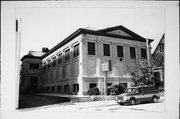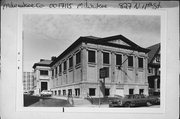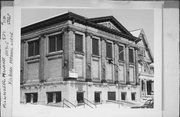| Additional Information: | A 'site file' exists for this property. It contains additional information such as correspondence, newspaper clippings, or historical information. It is a public record and may be viewed in person at the Wisconsin Historical Society, State Historic Preservation Office.
DESCRIPTION:
The Kilbourn Masonic Temple is a two story Neo-Classical Revival style structure designed by H. Paul Schnetzky and Son in 1911. It was built by C. A. Kleppe and masonry work was done by Paul Riesen Sons. (A). This temple-like form surrounds a former residence on the site. A portion of that residence is still visible at the rear. The main facade along 11th Street is relatively simple and features six Ionic pilasters resting on a raised stone foundation. An abbreviated pediment surmounts the pilasters and intersects a hipped roof. Rectangular windows are located at the second story level only with blind brick panels responding to them at the first story level. This arrangement of windows and pilasters continues across the north and south elevations. The main entrance is located to the rear of the south elevation in a rectangular bay which projects perpendicular to the main body of the building. A front entry was installed in 1935 in the 11th Street facade at the basement level. The exterior is otherwise unchanged since 1911.
The main hall of the temple is a large open room lit by the second story windows referred to above. Short pilasters separate the pairs of windows and extend only two thirds of the way down the wall to terminate at a cornice that runs the perimeter of the room. Capitals are of an abstracted floral pattern and are not attributable to any classical prototype. The room is oriented toward a recessed alcove at the west end with a dais and chairs for the Masonic officials.
A pair of battered Egyptian revival door frames flank this recess and winged figures ornament the cavetto cornice. The beamed ceiling had leaded-glass, bowl-shaped pendant light fixtures down the center with shaded hanging lamps along the sides of the room. Furnishings, evident from historic photographs, were mission-inspired and some of the chairs were decorated with winged figures. The fireplaces and staircases of the original masion remain intact in other parts of the building.
ARCHITECTURAL/ENGINEERING SIGNIFICANCE:
The Kilbourn Masonic Temple is architecturally significant as a dignified Neo-Classical Revival structure exhibiting high quality design. The project is made more interesting because it is actually a remodeling of a large nineteenth century residence which remains mostly intact behind its imposing new front. H. Paul Schnetzky was a prominent Milwaukee architect who is better known for the works he collaborated on with Eugene R. Liebert. Schnetzky had a predilection for classically-inspired designs of which the Kilbourn Lodge is one of the best of his small commissions.
HISTORICAL BACKGROUND:
The first Masonic meeting in Milwaukee took place on July 5, 1843, at which time there were about 40-50 Masons in the city. They petitioned for a dispensation under which a lodge of Free and Accepted Masons could be organized. Approval came from the Grand Master in Springfield, Illinois. The document was dated June 12, 1843, but signed January 17, 1844. The initial Lodge was first called the Milwaukee Lodge but later became known as Kilbourn Lodge # 3 after the adoption of changes in the bylaws.
After this, numerous other lodges were chartered, including the Royal Arch Masons (chartered February 16, 1844), the Blue Lodges (chartered September 7, 1872) and the Commandery, which was organized on June 12, 1850.
Kilbourn Lodge # 3 met at the Masonic Temple on today's North Plankinton Avenue, between West Wisconsin and Wells, until 1899. After occupying two temporary headquarters, Kilbourn Lodge # 3 settled into the clubhouse it still uses today at 827 North 11th Street. The site was occupied by an old residence that the masons remodeled by constructing a new classical facade designed by H. Paul Schnetzky and Son that completely enclosed the former dwelling. (B, C).
HISTORICAL SIGNIFICANCE:
The Kilbourn Lodge # 3 is primarily of historical significance as the first Masonic lodge to be chartered in Milwaukee and one of the original three lodges to be established in Wisconsin in 1843. Milwaukee's 40 to 50 practicing Masons at that time had been subject to the dictates of the Grand Master of Illinois before organizing their own lodge. Milwaukee's Kilbourn Lodge, together with the Mineral Point and Melody Lodges, organized the Grand Lodge of the State of Wisconsin in 1843 which governed all masonic activities for the state. The Kilbourn Lodge was named after one of the chapters most illustrious presidents, Byron Kilbourn.
Individuals associated with this building include Charles Von Baumbach from 1873 to 1885 and Dr. and Mrs. Reinhard from 1894 to 1910. (B, C). |
|---|
| Bibliographic References: | A. Milwaukee City Building Permits.
B. Conard, Howard Lewis, "History of Milwaukee County." Vol. II. Chicago: American Biographical Publishing Company, 1895, p. 280.
C. "History of Milwaukee, Wisconsin." Chicago: The Western Historical Company, 1881. p. 959.
D. Steele, Glen. Letter to Milwaukee Landmarks Commission, July 22, 1973.
Facade. |
|---|



